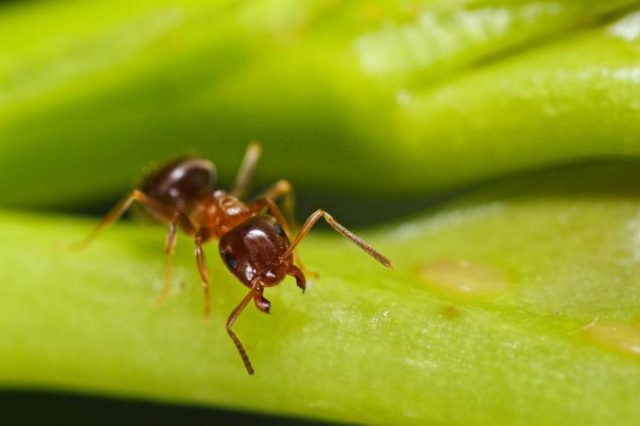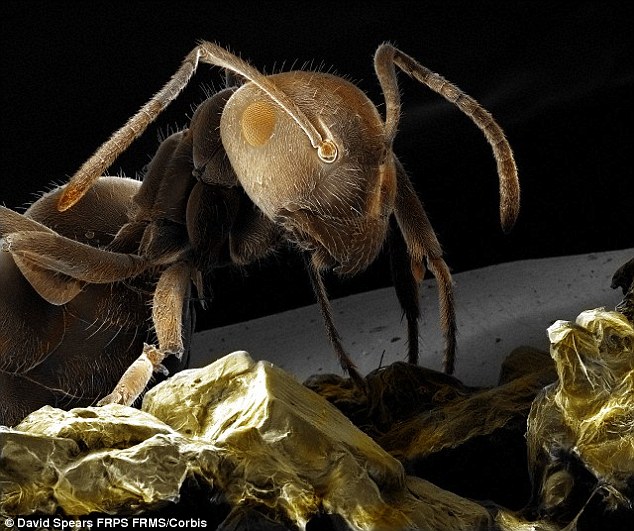The ants’ toilet, please?

Ant nests are complex three-dimensional spaces with particular places allocated for specific functions: egg-laying, care of the brood, food storage… In the chambers and tunnels, many insects live in very confined spaces and are thus especially vulnerable for infectious diseases. Feces are hazardous materials since theoretically at least they can foster bacteria, transmit diseases, and generally put the colony in danger. Then, what do ants with feces?
Tom Czaczkes and his group from the University of Regensburg (Germany) studied 21 small, lab-grown colonies of black garden ants (Lasius niger) 1. The ants were housed in plaster nests and selectively fed with a sugar solution colored with food dye. Some ants got red while others got blue. They also gave the ants a colored protein jelly, stained with a different dye, which usually adult worker ants do not eat since it can be lethal to them.

After two months, the researchers revised the colonies and found a particular behavior of the ants where they form patches of fecal material in the corners of specific chambers of their intricate underground colonies, «toilets». Distinct, localized, colored patches were identified by an uninformed observed in all 21 nests. The patches were always the same color as the sugar solution presented and between 1 and 4 patches were observed in each nest (mean 2.32, median 2). No trace of the protein color was found in the patches.
Other waste material such as uneaten food items, including the protein jelly, and nestmate corpses were located in piles outside the nest and were never found in the toilet areas. In three of the 21 colonies, a distinct patch of the same color as the sugar solution was also found outside the nest, in addition to the patch/patches found inside the nest. The ants may have considered some parts of their foraging arena as part of their nest. Then, feces were neither let them lie about nor removed completely from the colony. The insects were meticulously sanitary when it comes to where they leave them, forming deposits in just one or two places of the nest. The ants did not appear to avoid walking through these places and the research team is keen to investigate whether workers carry the brood to these areas of the nest or keep them away.

The presence of the fecal areas inside the nests suggests that they are not a probable risk for the health of the nest conspecifics and may have a beneficial role. In other species, feces are put to use, either as a construction material, as fertilizer or as a long-lasting signal. Some beetle larvae use them as a defensive shield and some termites produce waste that has antimicrobial properties, a material which helps keep the colony healthy. There did not appear to be any fungi growing on the toilet areas, but when ants were removed from the nest some fungi did grow. Another option is that the fecal material contains salts or nutrients crucial for ant larvae, a material useful but to store separated from other food products. It is also possible that ants treat the feces with formic acid or another antibiotic substance, as they do with brood exposed to pathogenic fungal spores 2. A possible bonus could be the bonding time. Naked mole rats regularly visit the toilet areas in their colony and rub their bodies with the waste to coat themselves with pheromones that identify them as members of the group 3. It is also possible that the feces produced by L. niger may be liquid, and so not easily transportable. A third possibility is that ants avoid defecating outside the nest so as to avoid attracting predators to the nest, but as L. niger form pheromone trails leading directly to the nest, mark the nest surroundings with home-range markings, and remove corpses and food waste, this explanation also seems unlikely.
The toilet system observed by Czaczkes and his coworkers is not the only option for dealing with feces by social arthropods. Honey bees, for example, perform defecation flights and even the very young bees, which otherwise do not leave the hive, do these sanitary flights. Other species of ants form a refuse pile outside the nest, where feces and different wastes are deposited. Some social spider mites create a localized fecal pile just inside the entrance to their silk shelter (1). All they can say that old truth: «Shit happens. But life goes on».
References
- Czaczkes TJ, Heinze J, Ruther J (2015) Nest etiquette–where ants go when nature calls. PLoS One 10(2): e0118376. doi: 10.1371/journal.pone.0118376. eCollection 2015. ↩
- Gray R (2015) Ants build en-suite ‘TOILETS’: Insects use allocated corner of their nest as lavatories – and use the waste as manure. Daily Mail 19 February. ↩
- Bittel J (2015) Ants Maintain ‘Toilets’ in Their Nests, First-Ever Study Shows. National Geographic 12 February 2015 ↩
1 comment
[…] La gestión que las hormigas hacen de los desperdicios en el hormiguero es, como mínimo, sorprendente. José Ramón Alonso en The ants’ toilet, please? […]